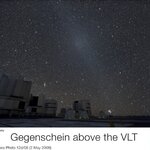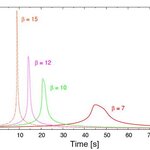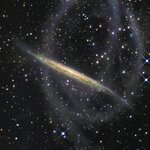Space

Here's a fun experiment, one you've probably done already a million times: stick your arm out in front of you. Stick up your left thumb, like you're giving the thumbs up. Close one eye - see where your thumb is? Okay, now switch eyes and close the other one. Did your thumb move? The next step - move your thumb a little closer. Now do it all over again. Did it seem like your thumb was moving even more than before?
What you just did with your thumb is a lot like how scientists measure how far away stars are from Earth. Even though your thumb didn't really move, it appeared to move when…
Hello, Ms. Nufer's class, and welcome to your very own blog about science! Since you're learning about astronomy right now, I'll keep you updated on news from the astronomy field. If you have questions or comments, be sure to submit them and I'll get back to you on this site. Sound good? Let's get started!This first posting is about constellations, or "pictures" in the sky. I'll start with a history lesson, then talk about some of the major constellations, and then put in a few pictures.People have been tracing pictures in the sky for thousands of years, not only to tell stories but to…

The Antennae Galaxies, located in the constellation of Corvus (the Crow), are among the closest known merging galaxies. The two galaxies, also known as NGC 4038 and NGC 4039, began interacting a few hundred million years ago, creating one of the most impressive sights in the night sky. They are considered by scientists as the archetypal merging galaxy system and are used as a standard against which to validate theories about galaxy evolution.
Scientists using Hubble’s Advanced Camera for Surveys and Wide Field Planetary Camera 2 to observe individual stars spawned by the colossal cosmic…

A team of Dutch and German astronomers have discovered part of the missing matter in the Universe using the European X-ray satellite XMM-Newton. They observed a filament of hot gas connecting two clusters of galaxies. This tenuous hot gas could be part of the missing “baryonic” matter.
The existence of this hot gas (with a temperature of 100 000 - 10 000 000 degrees), known as a warm-hot intergalactic medium, was predicted 10 years ago as a possible source for the missing dark matter. Gas at such high temperature and low density is very difficult to detect and many attempts have failed in…

A group of researchers writing in Geophysical Research Letters have a new theory about Mercury’s mysterious magnetic field - iron “snow” inside the planet that forms and falls toward the center, much like snowflakes form in Earth’s atmosphere and fall to the ground.
Mercury is the closest planet to the sun and the only other terrestrial planet that possesses a global magnetic field. Discovered in the 1970s by NASA’s Mariner 10 spacecraft, Mercury’s magnetic field is about 100 times weaker than Earth’s. Most models cannot account for such a weak magnetic field.
Made mostly of iron, Mercury’s…

The Earth's atmosphere is a gigantic prism that disperses sunlight. In the most ideal atmospheric conditions, such as those found regularly above Cerro Paranal, this will lead to the appearance of so-called green and blue flashes at sunset. The phenomenon is so popular on the site that it is now the tradition for the Paranal staff to gather daily on the telescope platform to observe the sunset and its possible green flash before starting their long night of observations.
The green and blue flashes are fleeting events that require an unobstructed view of the setting Sun, and a very stable…

It makes sense that massive black holes lurking in galactic nuclei and weighing millions of Suns can disrupt stars that come too close. Astrophysicists say that the black hole’s gravity pulls harder on the nearest part of the star, an imbalance that pulls the star apart over a period of hours, once it gets inside the so-called "tidal radius."
Two astrophysicists from Paris Observatory say the fate of stars that venture too close to massive black holes could be even more violent than previously believed. Not only are they crushed by the black hole’s huge gravity, but the process can also…
At the cores of many galaxies, supermassive black holes expel powerful jets of particles at nearly the speed of light. Just how they perform this feat has long been one of the mysteries of astrophysics. The leading theory says the particles are accelerated by tightly-twisted magnetic fields close to the black hole, but confirming that idea required an elusive close-up view of the jet's inner throat. Now, using the unrivaled resolution of the National Radio Astronomy Observatory's Very Long Baseline Array (VLBA), astronomers have watched material winding a corkscrew outward path and behaving…

Data from the ESA/NASA spacecraft SOHO shows clearly that powerful starquakes ripple around the Sun in the wake of mighty solar flares that explode above its surface. The observations give solar physicists new insight into a long-running solar mystery and may even provide a way of studying other stars.
The outermost quarter of the Sun’s interior is a constantly churning maelstrom of hot gas. Turbulence in this region causes ripples that criss-cross the solar surface, making it heave up and down in a patchwork pattern of peaks and troughs.
A frequency-time diagram of global oscillations in…

Huge star streams in the outskirts of two nearby spiral galaxies have allowed astronomers to obtain a panoramic overview of ' galactic cannibalism' similar to that involving the Sagittarius dwarf galaxy in the vicinity of the Milky Way.
The detection of these immense stellar fossils confirms the predictions of the cold dark matter model of cosmology, which proposes that present-day grand design spiral galaxies were formed from the merging of less massive stellar systems.
The first of these debris structures surrounds the galaxy NGC 5907, located 40 million light-years from Earth and formed…